也谈旅游跨文化交际-2019年精选文档
- 格式:doc
- 大小:21.00 KB
- 文档页数:6
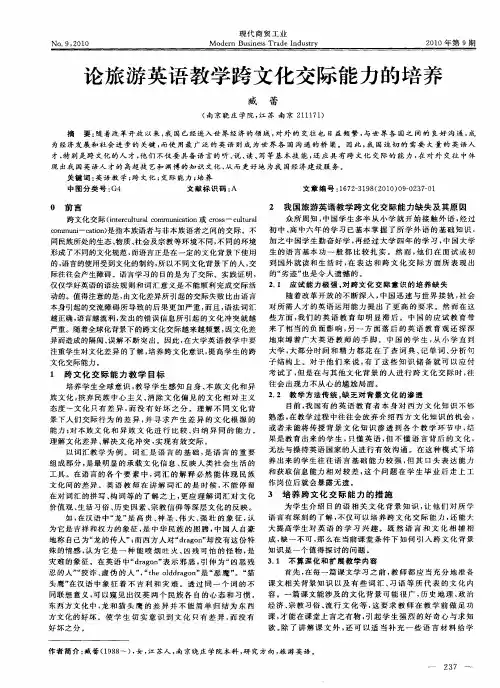
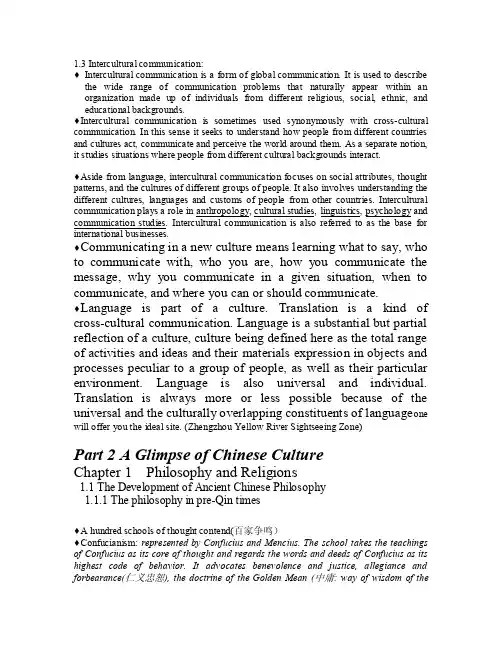
1.3 Intercultural communication:♦Intercultural communication is a form of global communication. It is used to describe the wide range of communication problems that naturally appear within an organization made up of individuals from different religious, social, ethnic, and educational backgrounds.♦Intercultural communication is sometimes used synonymously with cross-cultural communication. In this sense it seeks to understand how people from different countries and cultures act, communicate and perceive the world around them. As a separate notion, it studies situations where people from different cultural backgrounds interact.♦Aside from language, intercultural communication focuses on social attributes, thought patterns, and the cultures of different groups of people. It also involves understanding the different cultures, languages and customs of people from other countries. Intercultural communication plays a role in anthropology, cultural studies, linguistics, psychology and communication studies. Intercultural communication is also referred to as the base for international businesses.♦Communicating in a new culture means learning what to say, who to communicate with, who you are, how you communicate the message, why you communicate in a given situation, when to communicate, and where you can or should communicate.♦Language is part of a culture. Translation is a kind of cross-cultural communication. Language is a substantial but partial reflection of a culture, culture being defined here as the total range of activities and ideas and their materials expression in objects and processes peculiar to a group of people, as well as their particular environment. Language is also universal and individual. Translation is always more or less possible because of the universal and the culturally overlapping constituents of language one will offer you the ideal site. (Zhengzhou Yellow River Sightseeing Zone)Part 2 A Glimpse of Chinese CultureChapter 1 Philosophy and Religions1.1 The Development of Ancient Chinese Philosophy1.1.1 The philosophy in pre-Qin times♦A hundred schools of thought contend(百家争鸣)♦Confucianism: represented by Confucius and Mencius. The school takes the teachings of Confucius as its core of thought and regards the words and deeds of Confucius as its highest code of behavior. It advocates benevolence and justice, allegiance and forbearance(仁义忠恕), the doctrine of the Golden Mean (中庸: way of wisdom of theConfucian school, which advocates impartiality, reconciliation and compromise in one’s approach to people or matters)and values the ethical relations of men. It emphasizes the importance of family and societal order.♦Taoism: is a school of thought founded by Laozi and Zhuangzi. The school advocates the doctrine that the Dao is the course, the principle, the substance, and the standard of all things, to which all people must conform. Based on the work of Lao Zi or Dao De Jing (道德经),Taoism promotes the belief that a person should live a simple life, not to strive for wealth, fame or power, which will only give one worries and trouble. With proper behavior and self-restraint, a person can achieve great inner strength and a prolonged life.♦The school favors the political principle of “ achieving good government through non-action”.♦Mohism, based on the teachings of Mo Zi, cherishes universal love which states that if all the people in the world loved each other, there would be no hatred, calamities(灾难), and hostilities. In politics and ethics Mohism advocates honoring virtuous people, opposing fatalism(宿命论) and aggressive wars, and upholding thriftiness and simple funerals.♦Legalism, begun by Han Feizi, espouses(主张) laying down laws to unify the thought of people, promoting agriculture to achieve affluence(富裕),waging(发动)wars to gain strength and power, and establishing a system of bureaucracy(官僚制度). The legalists also hold that contradiction is present everywhere, and the two sides of a contradiction are changeable.♦1.1.2 The orthodox philosophy during the Han dynasty(两汉经学)♦1.1.3 Metaphysics during the Wei and Jin dynasties(魏晋玄学)♦1.1.4 The Buddhist philosophy during the Sui and Tang dynasties(隋唐佛学)♦1.1.5 Neo-Confucianism in Song and Ming dynasties: the school of Principle( 理学) represented by Zhou Dunyi, Cheng Hao, Cheng Yi and Zhu Xi; the School of Mind(心学) by Wang Shouren and Lu Jiuyuan.(宋明理学)♦1.1.6 Application philosophy in the Ming and Qing dynasties(明清实学)♦1.2 The basic features of ancient Chinese philosophy♦Stress on Spiritual exsistence Stress on Practice Stress on Morality Stress on Harmony: Stress on intuition1.3 Characteristics of Chinese Ethics and Morality♦Ethics is the moral principle for dealing with people. Morality is a social ideology which serves as the norms for people’s lives and behaviors.♦The three obediences and four virtues(三从四德): to father before marriage, to husbandafter marriage, and to son after becoming a widow. Morality, proper speech, modest manner, and diligence♦The three basic rules and five constant virtues: a king should rule over his subjects, a father, his son; a husband, his wife. Benevolence, righteousness, propriety, wisdom, and fidelity.♦1.3.1 Seeking harmony and maintaining equilibrium(平衡)♦To Chinese people, harmony is a powerful word. There is nothing it cannot absorb and nothing it cannot cover. Harmony seeks peace, compromise, concord(一致), and unison(调和). Maintaining equilibrium is the ultimate purpose of harmony.♦1.3.2 Collectivism over individualism♦Traditional Chinese values attach great importance to collective interest. The interest of the society, the country and the family has always been given top priority, while that of the locality, the part, or the individual is sometimes ignored. An individual’s value can be realized only within society as a whole, as that is the groundwork of one’s existence.♦1.3.3 Spiritual life over material life♦Chinese people advocate morality in their behavior. Self-cultivation in morals is emphasized, and is considered to be more important that one’s material pursuits. This is fully characterized by showing filial obedience, being amiable(友善的) to others, respecting ordinary people and appreciating moral conduct.2. Chinese Religions♦2.1 The Taoist Religion♦Lu Xun once said: “ The Chinese roots are deep in Taoism . If one tries to comprehend Chinese history and culture, he must first comprehend Taoism and the Taoist religion.”♦It evolved out of witchcraft and necromancy and self-cultivation techniques. Its highest belief is called Dao and its bible is Do De Jing by Lao Zi.♦Taoist temples: Three Pure Gods(三清) of Jade Pure(玉清)who has a pearl within his fingers, Upper Pure(上清)who holds the universe in his arms and Great Pure(太清)who has a feather fan in his hand.♦Eight Immortals in the Taoist religion: “When the Eight Immortals cross the sea, each demonstrates his\her divine power(八仙过海各显神通)The most sacred Taoist mountain- Dragon-Tiger Mountain: is the birthplace of the Taoist religion and a key scenic and tourist resort located at the southwestern suburbof Yingtan, Jiangxi province.♦2.2 Buddhism♦Buddhism originated in India in the 6th century BC. Sakyamuni is said to be the founder of Buddhism. It was first introduced into China in the first century and has always co-existed with Confucianism and Taoism.♦The theory of Buddhism is based on the theory of samsara(轮回),meaning that living beings orbit around the six spheres of heaven, hell and earth, just like an ever-turning wheel. The path of a Buddhist is to achieve enlightenment.♦The cornerstone of Buddhist philosophy is the view that all life is suffering. Hence, the doctrine of Four Noble Truths(四谛):life is suffering, the cause of suffering is desire, the answer is to quench(抑制)desire, and the way to this end is to follow the Eight-Fold Path(八正道), which consists of right knowledge, right thought, right speech, right behavior, right livelihood, right mindfulness and right concentration.Buddhist temples♦It includes pagodas, temples and grottoes♦The Four Heavenly Kings ,the statue of Maitreya(Laughing Buddha) ,The Great Buddha Hall, the Eighteen Arhats♦The first Buddhist temple-the White Horse temple♦Mountains♦Wutai, Emei, Putuo and Jiuhua are accepted as the four sacred Buddhist mountains in China.♦2.3 Islam♦Islam was founded by the Arabic prophet(先知) Muhammad and was introduced into China in the seven century. For people of Islamic faith, there is only one god, Allah.♦The Arabic word “ Islam” simply means “ submission and obedience” . The word “Islamic” in Chinese literally means “pure and sincere(清真)”. A mosque is called Qingzhen temple which is always a high-domed building with sweeping arches, flowing arabesques(藤蔓花纹)and towering minarets(高耸的尖塔).♦The locations in the country.Chapter 2 Arts1. Calligraphy and Painting♦ 1. 1 Calligraphy♦♦Strokes of Chinese character♦Five categories of Chinese scripts: the seal form(篆书), the official form(隶书), the cursive form(草书), the regular form (楷书)and the running form(行书).♦1.2. Painting have the same origin as calligraphy(书画同源)♦Chinese traditional painting refers to ink-wash painting(水墨画):♦Mural painting(壁画)♦Wood-cut block print(木刻版画)♦1.3. Four treasures of the Study(文房四宝)♦Calligraphy tools- brush, ink, paper and ink stone. Each of these items is represented by the Hu brush(湖笔),Hui ink stick(徽墨), Xuan paper(宣纸),and Duan ink stone(端砚).2. Traditional Operas♦Chinese opera, together with Greek tragedy and comedy, and the Indian Sanskrit(印度佛教剧)are the three most ancient forms of drama in the world. Of these three, Chinese opera is the only remaining living form.♦2.1 Beijing Opera♦Towards the end of the 18th century, folk singers of Anhui and Hubei provinces , who were performing in Beijing at the time, created Beijing Opera by borrowing some of the plays, tunes, and acting skills and by absorbing some of their folk music and tunes from Kunqu Opera and Shaanxi Opera.♦Singing, recitation, acting, and acrobatic fighting(唱念做打)are the four artistic means and the four basic skills of Beijing Opera.♦Sheng, dan, jing, and chou♦The characters of Beijing Opera are classified according to sex, age, disposition, profession, and social status.♦Facial make-up and costumes2.2 Other major traditional Chinese operas♦Kunqu opera:is known for its gentle and clear vocals, beautiful and refined tunes, and dance-like stage performances. The Youth Version of the Peony Pavilion (青春版牡丹亭)♦Shaanxi Opera(秦腔)♦Is actually more of local yodeling(真假嗓音互换)♦Chuan opera (川剧): face changes♦Yue Opera(越剧)♦Huangmei Opera♦Yue Opera(粤剧)♦Yu Opera(豫剧)3. Folk Performing Arts♦Acrobatics(杂技)♦Quyi: Cross-talk, clapper talk(快板),storytelling(评书)xiaopin, shuanghuang(双簧)♦Puppet Show(木偶戏)♦Shadow Play(皮影戏)♦Ghost-Exorcising Opera(傩舞)Chapter 3 Traditional Chinese Medicine (TCM)TCM is very different from Western medicine in its means of diagnosis, treatment and its composition of drugs and prescriptions.♦Chinese practitioners of traditional medicine take a holistic(整体的)approach to diagnosis . They consider the whole body of the patient: his\her diet, age, habits, emotions, lifestyle and living environment. They pay particular attention to the causes of the sickness rather than the symptoms(症状). So, surgery to relieve symptoms is not encouraged in Chinese medicine.♦There are many ways that imbalances in QI can be corrected. These include acupuncture(针灸),herbal medicine, massage(按摩),diets, and corrective breathing exercises such as Taiji or Qigong.♦Listening, smelling, inquiring and observing, and feeling the pulse(望闻问切)are four diagnostic methods in TCM.♦Bian Que, Huo Tuo, Zhang Zhongjing, LI Shizhen and his Compendium of Meteria Medica(本草纲目)Chapter 4 Folk Customs♦ 1. Traditional festivals♦Spring festival, Dragon Boat festival and Mid-Autumn festival are three important traditional festivals in China.♦ 1.1 Spring festival: the time, the origins of the Nian, the spring festival couplets, foods, decorations, rituals, etc.♦ 1.2 Lantern festival♦ 1.3 Qingming festival : A riverside scene at Qingming festival(清明上河图)♦ 1.4 Dragon Boat festival♦ 1.5 Mid-Autumn festival♦ 1.6 Double Ninth festival♦2. Other traditional festivals: Double Seven festival, Laba and the Eight-treasure Porriage♦3. Ethnic festivals: Water Splashing festival by the Dai people in Yunnan, Nadam Fair by the Mongolian people, Torch festival by the Yi,Bai, Naxi,etc.2. Culinary Culture♦ 2.1 The features of Chinese food♦Color, aroma(香), and taste♦Cooking methods : boiling, stewing, braising, frying, stir-frying, quick-frying, deep-frying, frying and simmering, sautéing, simmering, smoking, roasting or barbecuing, baking, steaming and scalding.♦Seasonings (调味品):salty (salt, soy sauce), sweet (sugar, honey), sour (vinegar), pungent (chili, ginger, scallion), fragrant (sesame oil, coriander, wine), prickled (prickly ash) and tangy (monosodium glutamate) and bitter (dried tangerine, bitter apricot kernel). ♦Medicinal function♦2.2 Eight regional cuisines: Shandong, Guangdong, Sichuan, Jiangsu, Zhejiang, Hunan, Anhui and Fujian cuisines.♦One popular summary of Chinese food is “sweet in the south, salty in the north, sour in the west and spicy in the east.Chapter 2 Family Values♦1. American Family♦In the United States the nuclear family, which consists of the father, the mother, and the children, is cons idered “the family”. The extended family, common in other cultures, includes grandparent, aunts, uncles, cousins, nephews, nieces, and in-laws. The distinction between the nuclear and extended family is important because it suggests the extent of family ties and obligations. In extended families the children and parents have strong ties and obligations to relatives. It is common in these families to support older family members, to have intensive contact with relatives, and to establish communal housing.♦The American nuclear family usually has its own separate residence and is economically independent of other family members. Relatives are still considered “family” but are often outside the basic obligations that people have to their immediate families.♦When couples marry, they are expected to live independently of their parents and become “heads of households” when they have children. It is not unusually in times of financial need for nuclear family members to borrow money from a bank rather than from relatives. Grandparents, aunts, uncles, and cousins, then, are not directly involved in the same way as they would be in extended family structure.♦In both nuclear and extended families, the culture imposes set roles upon parents. Traditionally the male has been responsible for financial support of the home and family members. The female has often been responsible for emotional support, child raising, and housekeeping. However, among people in some parts of the U.S these parental functions are no longer fix ed. The prescribed role of the man as “breadwinner” and the woman as housewife is changing. These changes include working mothers, “househusbands”, and an increasing number of daycare centers for children.2. Family Structure in Britain♦The British live longer, marry later, have fewer children and are more likely to get divorced than ever before. Young people leave home earlier, though not necessarily to get married. More women now go out to work and more people, especially the old, live alone. The nuclear family has largely replaced the extended family where several generations lived together.♦Although patterns are changing, most people in Britain still get married and have children and stay together until the end of their lives. People are marrying later: the average woman gets married at 24 to a man who is just over two years older.♦Britain has one of the highest divorce rates in Western Europe: approximately one in three marriages ends in divorce, half of them in the first ten years of marriage.3. The Elderly in America♦The financial support of the elderly is often provided by social security or welfare systems which decrease dependence on their family. Additionally, older people may seek their own friends rather than become too emotionally dependent on their children.♦Some families send their old relatives to nursing homes rather than integrate them into the homes of the children or grandchildren. This separation of the elderly from the young has contributed to the isolation of an increasingly large segment of society. On the other hand, there are many old people who choose to live in retirement communities where they have the companionship of other older people and the convenience of many recreational and social activities close to home.4. Youngsters in America♦Many children are taught at a very early age to make decisions and be responsible for their actions. Often children work for money outside the home as a first step to establishing autonomy.♦Receiving a weekly allowance at an early age teaches children to budget their money, preparing them for future financial independence. Many parents believe that managing money helps children learn responsibility as well as appreciate the value of money.♦Upon reaching an appropriate age (18-21), children are encouraged, but not forced, to “ leave the nest” and begin an independent life. After children leave home they often find social relationships and financial support outside the family.♦Parents do not arrange marriages for their children, nor do children usually ask permission of their parents to get married. Romantic love is most often the basis for marriage in the United States; young adults meet their future spouses through friends, at school, at jobs, and in organizations and religious institutions. Although children choose their own spouses, they still hope their parents will approve of their choices.♦In many families, parents feel that children should make their major life decisions bythemselves. A parent may try to influence a child to follow a particular profession but the child is free to choose another career. Sometimes children do precisely the opposite of what their parents wish in order to assert their independence. A son may deliberately decide not to go into his father’s business bec ause of a fear that he will lose his autonomy in his father’s workplace.♦This independence from parents is not an indication that parents and children do not love each other. Strong love between parents and children is universal and this is no exception in the American family. Coexisting with such love in the American family are cultural values of self-reliance and independence.5. Time♦The varying attitudes toward time and its utilization held by the various cultures in the world means that serious misunderstandings may arise in intercultural communication unless those individuals involved are aware of, and sensitive to, a number of basic considerations.♦Americans and others in the Western world are said to live in the present and the near future and hence plan carefully. Other cultures, such as in the Middle East or Asia, live in their ancient pasts or in the far distant future and hence do not plan so carefully. To the Hindu and Buddhist this life is only one among countless lives yet to come, mere ly one dot in an endless serious of dots, so why plan?♦In order to use time well, they schedule the day and week and month carefully, set up timetables, and establish precise priorities. They prepare carefully for business conferences, for personal interviews, for group meetings of all types. This they assume to be elementary aspect of efficiency. But some Arabs, Asian and others look on this as obsessiveness, and aggressiveness. Their lack of planning communicates to Westerners laziness, inefficiency, and untrustworthiness.♦Americans expect an invitation to a dinner or a request for a date or for any other social event to be far in advance. Otherwise, it would be considered an insult. Some last minute invitations will be turned down. But in the Arab and Asian world, many simply forget appointments and arrangements if they are planned too far in advance, and their last minute invitations are sincere, and certainly not to be interpreted as insults.Americans place great stress on punctuality. Any consistently tardy person is taken to be undependable, untrustworthy, and disrespectful. For many situations Americans would consider tardiness of five minutes to be relatively serious and improper, but some other cultures would consider such an attitude to be a rather neurotic slavery to time. It is assumed that a busy, important person should come late. Hence, coming on time would only lower his prestige.。
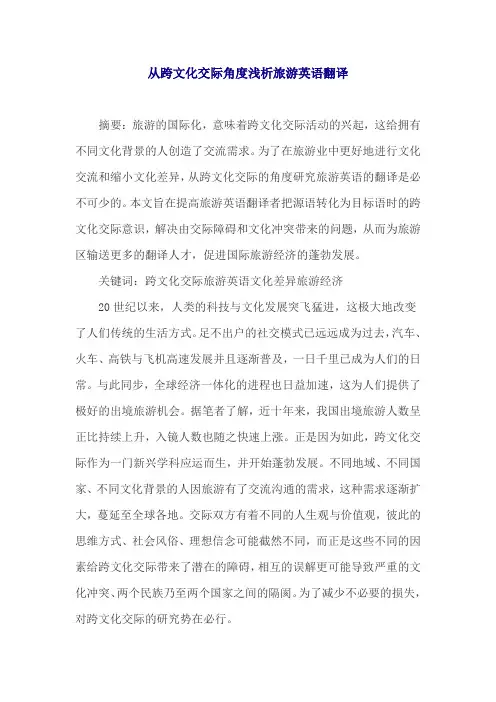
从跨文化交际角度浅析旅游英语翻译摘要:旅游的国际化,意味着跨文化交际活动的兴起,这给拥有不同文化背景的人创造了交流需求。
为了在旅游业中更好地进行文化交流和缩小文化差异,从跨文化交际的角度研究旅游英语的翻译是必不可少的。
本文旨在提高旅游英语翻译者把源语转化为目标语时的跨文化交际意识,解决由交际障碍和文化冲突带来的问题,从而为旅游区输送更多的翻译人才,促进国际旅游经济的蓬勃发展。
关键词:跨文化交际旅游英语文化差异旅游经济20世纪以来,人类的科技与文化发展突飞猛进,这极大地改变了人们传统的生活方式。
足不出户的社交模式已远远成为过去,汽车、火车、高铁与飞机高速发展并且逐渐普及,一日千里已成为人们的日常。
与此同步,全球经济一体化的进程也日益加速,这为人们提供了极好的出境旅游机会。
据笔者了解,近十年来,我国出境旅游人数呈正比持续上升,入镜人数也随之快速上涨。
正是因为如此,跨文化交际作为一门新兴学科应运而生,并开始蓬勃发展。
不同地域、不同国家、不同文化背景的人因旅游有了交流沟通的需求,这种需求逐渐扩大,蔓延至全球各地。
交际双方有着不同的人生观与价值观,彼此的思维方式、社会风俗、理想信念可能截然不同,而正是这些不同的因素给跨文化交际带来了潜在的障碍,相互的误解更可能导致严重的文化冲突、两个民族乃至两个国家之间的隔阂。
为了减少不必要的损失,对跨文化交际的研究势在必行。
1旅游英语中的跨文化交际跨文化交际是指在一个特定的交际情景中,具有不同文化背景(饮食、社交礼仪、制度习俗等)的交际者使用同一种语言(母语或目的语)进行的实时且直接的口语交际。
旅游活动是一种跨文化交际的文化交流过程,而旅游英语则是直接沟通这种跨文化交际的有效媒介之一。
[1]具备跨文化交际能力是旅游行业从业人员,尤其是出入境旅游从业人员的基本要求。
在经济全球化的时代背景下,中国的旅游业,尤其是出入境旅游,得到了持续快速的发展,迅速成为国民经济中发展速度最快的行业之一。
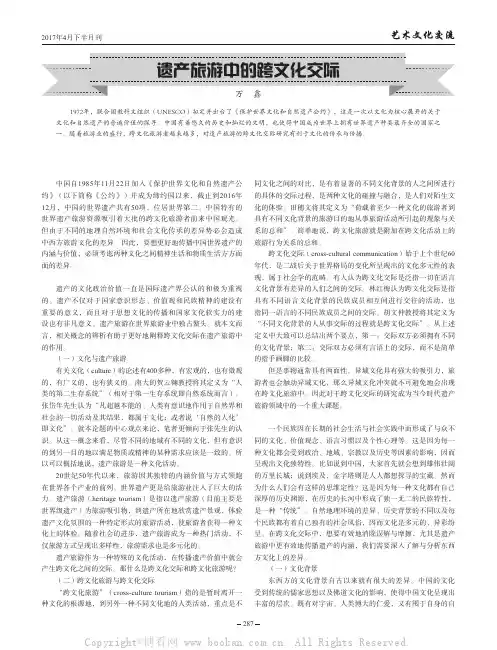

从泰国繁荣的旅游业看其跨文化交际意识及语言的普及本文从泰国政府的国内外高水平的旅游外交宣传攻略,泰国人民强大的跨文化交际意识和能力,以及旅游业发展、经济发展和跨文化交际所必需的语言环境的良好普及等三方面,深入分析了其旅游业蓬勃发展的成功原因。
总结了泰国的经验对我国的不同文化的兼容并蓄的时代发展性要求、全民跨文化交际意识的培养的重要性及语言普及的理论意义和实用价值。
标签:语言普及跨文化交际意识旅游业共识一、引言泰国的旅游业蓬勃发展,国际影响很大,中国人、欧美人游泰的兴趣越来越浓之风,有目共睹。
其中的不少因素是可以引起和值得我们的足够的研究、分析和借鉴的。
我们主要可从泰国国内、国外对外交际交流两方面情况来分析它的成功原因。
1.国内日常实际情况可用服务细致周到来形容。
进入泰国,你若使用英语,可轻松走遍泰国,无须导游。
吃、住、行、游、购、娱、或想对泰进行一些旅游、文化之类的研究考察等都较方便。
因为泰的各家宾馆饭店、展览馆、娱乐场所、学校等大都使用英语,都有全面配套的英语宣传册、英语书刊、杂志、地图册、名片等,旅游宣传促销工作全面到位。
在一些大型表演场、或民族歌舞表演场所,不但有书面英语介绍,还有现场口译,边演边介绍、语言能力较强,常引来游客的阵阵欢笑、共鸣。
有的宾馆、饭店还邀请著名大学教授作各种泰国文化英语演讲、介绍讲座。
旅游促销手段、策略之多、之佳,跨文化交际意识之强,令人寻味。
所到之处,各种人员都或多或少可用英语与外宾交谈,沟通。
令人感觉全民英语素质、基础普遍较好,跨文化交际能力较强,电视英语频道多,英语故事片、节目多。
所有公共场合,广告牌,提示牌等基本是双语解释,(即泰语和英语),或多语解释。
著名景点大王宫里,还有多种文字介绍的精美宣传册—日本语、汉语、英语、泰语等,均免费提供。
由此也可见泰旅游当局对旅游管理、接待水平之成熟,对跨文化交际的推广的重视、语言文化能力之强。
2.国际旅游宣传促销情况可用有计划、有策略,主动重点出击来概括。
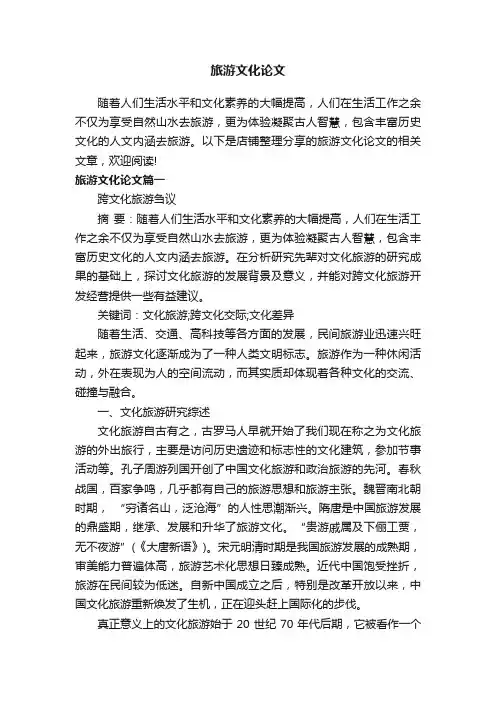
旅游文化论文随着人们生活水平和文化素养的大幅提高,人们在生活工作之余不仅为享受自然山水去旅游,更为体验凝聚古人智慧,包含丰富历史文化的人文内涵去旅游。
以下是店铺整理分享的旅游文化论文的相关文章,欢迎阅读!旅游文化论文篇一跨文化旅游刍议摘要:随着人们生活水平和文化素养的大幅提高,人们在生活工作之余不仅为享受自然山水去旅游,更为体验凝聚古人智慧,包含丰富历史文化的人文内涵去旅游。
在分析研究先辈对文化旅游的研究成果的基础上,探讨文化旅游的发展背景及意义,并能对跨文化旅游开发经营提供一些有益建议。
关键词:文化旅游;跨文化交际;文化差异随着生活、交通、高科技等各方面的发展,民间旅游业迅速兴旺起来,旅游文化逐渐成为了一种人类文明标志。
旅游作为一种休闲活动,外在表现为人的空间流动,而其实质却体现着各种文化的交流、碰撞与融合。
一、文化旅游研究综述文化旅游自古有之,古罗马人早就开始了我们现在称之为文化旅游的外出旅行,主要是访问历史遗迹和标志性的文化建筑,参加节事活动等。
孔子周游列国开创了中国文化旅游和政治旅游的先河。
春秋战国,百家争鸣,几乎都有自己的旅游思想和旅游主张。
魏晋南北朝时期,“穷诸名山,泛沧海”的人性思潮渐兴。
隋唐是中国旅游发展的鼎盛期,继承、发展和升华了旅游文化。
“贵游戚属及下俪工贾,无不夜游”(《大唐新语》)。
宋元明清时期是我国旅游发展的成熟期,审美能力普遍体高,旅游艺术化思想日臻成熟。
近代中国饱受挫折,旅游在民间较为低迷。
自新中国成立之后,特别是改革开放以来,中国文化旅游重新焕发了生机,正在迎头赶上国际化的步伐。
真正意义上的文化旅游始于20世纪70年代后期,它被看作一个特殊的旅游产品种类,而且旅游者大都是受过良好教育,家境富裕的一小部分人。
直到90年代,人们才对文化旅游的实质加以确认:它是一种特色鲜明的、拥有大众市场的活动(Mckercher & Cros, 2006)。
对于文化旅游的内涵定义,许多学者还没有达成统一的定义。
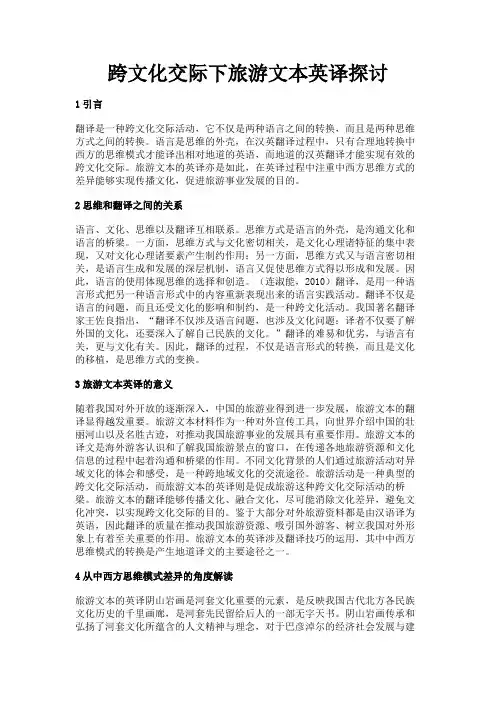
跨文化交际下旅游文本英译探讨1引言翻译是一种跨文化交际活动,它不仅是两种语言之间的转换,而且是两种思维方式之间的转换。
语言是思维的外壳,在汉英翻译过程中,只有合理地转换中西方的思维模式才能译出相对地道的英语,而地道的汉英翻译才能实现有效的跨文化交际。
旅游文本的英译亦是如此,在英译过程中注重中西方思维方式的差异能够实现传播文化,促进旅游事业发展的目的。
2思维和翻译之间的关系语言、文化、思维以及翻译互相联系。
思维方式是语言的外壳,是沟通文化和语言的桥梁。
一方面,思维方式与文化密切相关,是文化心理诸特征的集中表现,又对文化心理诸要素产生制约作用;另一方面,思维方式又与语言密切相关,是语言生成和发展的深层机制,语言又促使思维方式得以形成和发展。
因此,语言的使用体现思维的选择和创造。
(连淑能,2010)翻译,是用一种语言形式把另一种语言形式中的内容重新表现出来的语言实践活动。
翻译不仅是语言的问题,而且还受文化的影响和制约,是一种跨文化活动。
我国著名翻译家王佐良指出,“翻译不仅涉及语言问题,也涉及文化问题;译者不仅要了解外国的文化,还要深入了解自己民族的文化。
”翻译的难易和优劣,与语言有关,更与文化有关。
因此,翻译的过程,不仅是语言形式的转换,而且是文化的移植,是思维方式的变换。
3旅游文本英译的意义随着我国对外开放的逐渐深入,中国的旅游业得到进一步发展,旅游文本的翻译显得越发重要。
旅游文本材料作为一种对外宣传工具,向世界介绍中国的壮丽河山以及名胜古迹,对推动我国旅游事业的发展具有重要作用。
旅游文本的译文是海外游客认识和了解我国旅游景点的窗口,在传递各地旅游资源和文化信息的过程中起着沟通和桥梁的作用。
不同文化背景的人们通过旅游活动对异域文化的体会和感受,是一种跨地域文化的交流途径。
旅游活动是一种典型的跨文化交际活动,而旅游文本的英译则是促成旅游这种跨文化交际活动的桥梁。
旅游文本的翻译能够传播文化、融合文化,尽可能消除文化差异,避免文化冲突,以实现跨文化交际的目的。
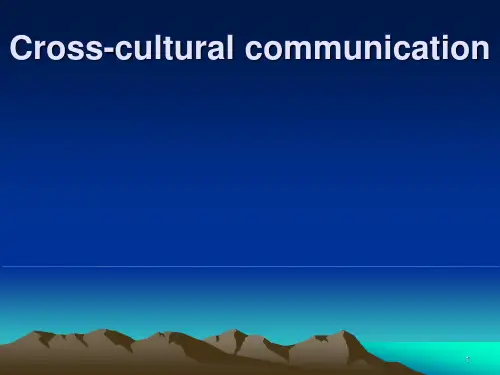
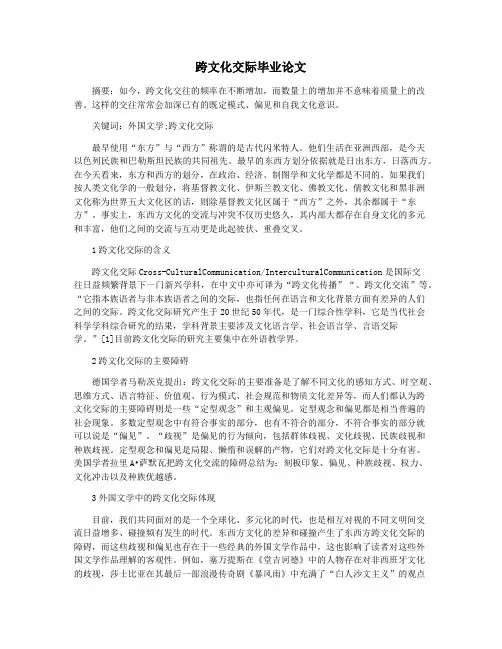
跨文化交际毕业论文摘要:如今,跨文化交往的频率在不断增加,而数量上的增加并不意味着质量上的改善。
这样的交往常常会加深已有的既定模式、偏见和自我文化意识。
关键词:外国文学;跨文化交际最早使用“东方”与“西方”称谓的是古代闪米特人。
他们生活在亚洲西部,是今天以色列民族和巴勒斯坦民族的共同祖先。
最早的东西方划分依据就是日出东方,日落西方。
在今天看来,东方和西方的划分,在政治、经济、制图学和文化学都是不同的。
如果我们按人类文化学的一般划分,将基督教文化、伊斯兰教文化、佛教文化、儒教文化和黑非洲文化称为世界五大文化区的话,则除基督教文化区属于“西方”之外,其余都属于“东方”。
事实上,东西方文化的交流与冲突不仅历史悠久,其内部大都存在自身文化的多元和丰富,他们之间的交流与互动更是此起彼伏、重叠交叉。
1跨文化交际的含义跨文化交际Cross-CulturalCommunication/InterculturalCommunication是国际交往日益频繁背景下一门新兴学科,在中文中亦可译为“跨文化传播”“、跨文化交流”等。
“它指本族语者与非本族语者之间的交际,也指任何在语言和文化背景方面有差异的人们之间的交际。
跨文化交际研究产生于20世纪50年代,是一门综合性学科,它是当代社会科学学科综合研究的结果,学科背景主要涉及文化语言学、社会语言学、言语交际学。
”[1]目前跨文化交际的研究主要集中在外语教学界。
2跨文化交际的主要障碍德国学者马勒茨克提出:跨文化交际的主要准备是了解不同文化的感知方式、时空观、思维方式、语言特征、价值观、行为模式、社会规范和物质文化差异等,而人们都认为跨文化交际的主要障碍则是一些“定型观念”和主观偏见。
定型观念和偏见都是相当普遍的社会现象。
多数定型观念中有符合事实的部分,也有不符合的部分,不符合事实的部分就可以说是“偏见”。
“歧视”是偏见的行为倾向,包括群体歧视、文化歧视、民族歧视和种族歧视。
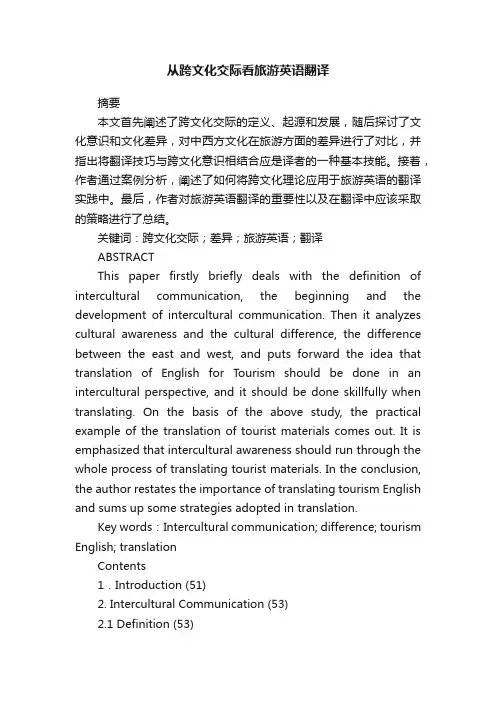
从跨文化交际看旅游英语翻译摘要本文首先阐述了跨文化交际的定义、起源和发展,随后探讨了文化意识和文化差异,对中西方文化在旅游方面的差异进行了对比,并指出将翻译技巧与跨文化意识相结合应是译者的一种基本技能。
接着,作者通过案例分析,阐述了如何将跨文化理论应用于旅游英语的翻译实践中。
最后,作者对旅游英语翻译的重要性以及在翻译中应该采取的策略进行了总结。
关键词:跨文化交际;差异;旅游英语;翻译ABSTRACTThis paper firstly briefly deals with the definition of intercultural communication, the beginning and the development of intercultural communication. Then it analyzes cultural awareness and the cultural difference, the difference between the east and west, and puts forward the idea that translation of English for T ourism should be done in an intercultural perspective, and it should be done skillfully when translating. On the basis of the above study, the practical example of the translation of tourist materials comes out. It is emphasized that intercultural awareness should run through the whole process of translating tourist materials. In the conclusion, the author restates the importance of translating tourism English and sums up some strategies adopted in translation.Key words:Intercultural communication; difference; tourism English; translationContents1.Introduction (51)2. Intercultural Communication (53)2.1 Definition (53)2.2 Origin (54)2.3Development of Intercultural Communication?s Application in T ourismTranslation (54)3. Intercultural Communication Difference in T ourism Translation (57)3.1 Difference in V ocabulary (57)3.2 Difference in Syntax Structure (58)3.3 Difference in Culture (59)3.3.1 Difference in Psychology (60)3.3.2 Difference in Conventions (60)3.3.3 Difference in Historical Culture (61)3.3.4 Difference in Thinking Modes (61)3.3.5 Difference in Aesthetic Taste (62)4. Intercultural Communication Awareness in T ourism Translation (63)4.1 Translation from Intercultural Perspective (63)4.2 Case Studies (64)5.Conclusion (69)Acknowledgements ............................................................................ 错误!未定义书签。

一.跨文化交流的定义"跨文化交际"---"intercultural communication":指的是不同文化背景的个人之间的交际,也就是不同文化背景的人之间所发生的相互作用。
二.跨文化交流研究目的与研究内容研究目的:1)培养人们对不同的文化持积极理解的态度。
文化是有差异的,通过发现对方的不同点,反过来加深对我们自身文化的理解,从而做到客观地把握各自的文化特性。
在发现差异的过程中,也要注意不可忽视大量的共同之处。
2)培养跨文化接触时的适应能力。
初次与不同的文化接触时,往往会受到文化冲击(Culture shock),从而产生某种不适应。
要使交际得以继续下去,必须设法减缓冲击、提高适应能力。
3)培养跨文化交际的技能。
随着对外开放的进一步扩大,走出国门或留在国内参与跨文化交际的人越来越多,他们都需要学习、掌握与不同文化背景的人打交道时的实际技能。
在美国,除了在大学里设有这方面的课程之外,社会上,如商业界也有许多机构专门负责跨文化交际技能的培养,以适应国际化社会的需要。
可以说,正是基于这一点,跨文化交际研究的实践意义要大于理论意义。
研究内容:1)有关世界观、价值观方面的研究;2)言语行为的文化特性方面的研究;3)非语言交际方面的研究。
所谓世界观,就是人们对待世界的根本看法,包括人在宇宙中的位置、人与大自然的关系等诸多哲学方面的概念。
仅从人与大自然的关系来看,东西方文化有着截然不同的看法。
西方文化认为,人应该主宰自然,自然是人的征服对象,人类可以利用不断提高的科学技术改造自然、战胜自然,人是万物之中心。
与此对应,东方文化认为,人与自然是一种协调关系,人与自然紧密相关,人类不是改造自然,而是适应自然,利用自然的条件为人类服务。
所谓价值观,就是判断好坏、是非的标准,它会将人的行为引至某个方向。
因此,价值观就构成了文化与社会结构的基干。
对于隶属于某个文化的人来说,什么行为好,什么行为不好,都是受这个价值观的支配的。
简谈跨文化交际中的旅游英语翻译技巧汉语与在语言的表层结构和深层结构上不同,那么,在跨交际中的旅游英语翻译技巧是?一引言海南是一个多民族的岛屿,历史悠久,文化博大精深,源远流长。
自从成为国家经济特区以来,各行各业都得到了快速的发展,尤其是旅游业的发展蒸蒸日上。
2010年,国务院发布了《关于推进海南国际旅游岛建设发展的若干意见》,这就意味着海南岛已正式拉开了通往国际化旅游的帷幕,与国际旅游全方位接轨。
随着海南旅游业的国际化,观光海南的异国客人会越来越多,迫切需要既有专业知识又有跨文化交际能力的翻译。
旅游英语翻译不仅起着沟通国际间旅游桥梁的作用,更承载着东西文化交流的使命。
旅游是一种典型的跨文化交际活动,不同的国度有着不同的文化和习俗,所以不正确的旅游资料翻译不仅会阻碍交流的有效性,甚至还会引起误会,影响旅游业的发展。
要想把海南打造成“世界一流的旅游胜地”,对涉外旅游从业人员来说,不是简单地提供旅游翻译服务,而是必须了解异国文化的差异,使语言、文化与旅游三者在旅游英语的翻译应用中相互交融、相得益彰,使之在国际间文化交流中起着桥梁的作用,把博大精深的海南文化和现代海南的基本情况介绍给外国游客。
因此,迫切需要既有专业知识又有跨文化交际能力的翻译人才,要求他们有较强的跨文化意识,要担负起传播和保护本土的责任,又有能力巧妙地逾越中外文化差异带来的障碍,只有这样才能充分发挥翻译工作的桥梁和纽带作用。
二重视、尊重文化差异是做好翻译工作的前提文化差异存在于人类文明的任何阶段,每个民族、国家的文化都不同于另一个民族、国家的文化。
例如,西方人视红色为血腥,而中国人视红色为喜庆。
海南历史悠久,虽人口不多,却是中国少数民族聚居的省份之一,全省共有汉、黎、苗、回、藏、彝、壮、侗、瑶、白、泰、佤、水、京、土、布依等37个民族,这造就了海南复杂的文化背景。
著名的翻译家尤金·奈达指出:“对于真正成功的翻译而言,熟悉两种文化甚至比掌握两种语言更为重要……”不了解目标语文化,翻译出来的只是语言;了解其文化,才能翻译出符合目标语文化需求的篇章。
从功能翻译理论角度看旅游翻译的跨文化交际性摘要:功能翻译理论最初来源于二十世纪70年代的德国,其代表人物为德国的专家赖斯。
她主张翻译是一个有目标的行为,并批判了传统的翻译思想。
从赖斯以后产生了不少的研究者,并延伸了其翻译思想,包括威密尔的目的论、奈达的功能对等学说。
上述研究者都摈弃了原有的结构主义翻译方式,并进一步改进了各种功能翻译理论,使现代翻译运动从原有的桎梏中解脱了过来,对现代翻译发展起到了很大的引导和支持意义。
关键词:功能翻译理论;旅游翻译;跨文化交流引言:随着中国的对外开放,旅游翻译的重要性日益凸显。
但由于中外文化之间存在着很大的差异性,所以将旅游翻译视为一种跨文化交际活动,在各种功能翻译的理论研究视角下对其跨文化交际性研究也是十分必要的。
经过本文的深入探讨,期望对旅游翻译工作起到相应的作用,进而提升旅游翻译的服务质量,并促进旅游翻译等跨文化交际的健康发展。
一、从功能翻译理论看旅游翻译过程中的社会文化因素旅游翻译实际上也就是一个跨文化现象,一种交流现象,对旅游的译文也一样如此。
而旅游资源所表现不单单是独特的美学意义,其后面还蕴藏着很多社会文化元素。
可以说,旅游资源与社会文化元素息息相关,无法割裂,而社会文化元素是旅游资源的核心。
由于我国是一个有着大量人文景观和自然资源优势的国家,尤其是其所具备的大量历史景观资源,是我国五千多年历史文化的直接沉淀和累积,所以说旅游资源实际上也就是一个特殊的中国文化。
所以旅游翻译并不单纯是对我国旅游景观资源的简要描述,同时更是对其所具备的丰厚历史文化元素的传承。
所以,旅游翻译实际上也是一个跨文化交际活动,唯有透过翻译去除各种文化间所产生的差别,才能让外来游客更进一步地了解旅游资源中所蕴含的真谛。
二、从功能翻译视野下旅游翻译与跨文化交际性理论研究1、审美差异对文化翻译跨文化交流的影响作用从美学角度上来说,中国人更喜欢从主体意识上去想象描绘景物,将自身的情感融合到自然景观中去,因为在中国人看来自然景观是一个人自己感觉的外在反映,所以在描绘自然景观时中国人喜欢使用一些相对抽象的语言词汇,比如秀色可餐、人如游龙、水色山光等等。
也谈旅游跨文化交际
一、概念界定
人们普遍认为跨文化交际是指“具有不同文化背景的人从
事交际的过程”[1],是两种文化的碰撞与融合,是人们对陌生文化的体验。
因而,旅游跨文化交际被定义为荷载至少一种文化的旅游者到具有不同文化背景的旅游目的地从事旅游活动所引
起的现象与关系的总和[2]。
定义中的“不同文化背景”给我们的理解带来了麻烦,由于生活环境、生活方式、受教育程度、信仰、社会地位及其它经历的不同,没有两个人有完全一样的文化背景。
Marshall Singer 认为“没有两个人隶属的群体是完全相同的,即使在同一群体中,每个人的态度、价值和信念也不会完全一样。
因此,在文化上每个人都应该被认为是独特的。
……既然人们属于不同的群体,在每个群体中的看法又有差异,那么,严格说来,任何人与人之间的交际都应该被视为跨文化交流。
”[3]按照这样的观点,一切交际行为都属于跨文化交流的范畴,因为没有两个人所属的社会文化群体是完全一样的,没有两个交流者具有完全一致的知识。
依此说法,旅游者在旅游目的地的人际交往中接触到的三类行为主体:当地居民、旅游服务人员、其他旅游者,他们所构成的六种人际交往关系也都属于跨文化交流范畴(图1)[4]。
有人就此在空间上对跨文化交际进行分类,他们把跨文化交际分为
“宏观跨文化交际”与“微观跨文化交际”,前者指国际跨文化交际,后者指同一国家内不同文化圈层人民之间的交际,二者都属于intercultural communication(跨文化旅游)[5]。
因而,无论是国际旅游还是国内旅游,只要存在文化上的某些差异,都属于跨文化旅游。
然而,也有人认为旅游跨文化交际是指旅游者跨出国界在与母文化相异的文化环境中的旅游活动也即国际性的旅游活动[6]。
有人还引据强调[7]:在中国,一个上海人和一个北京人之间的交流,之所以不是跨文化交流,是因为即使现代上海人和北京人之间的生活方式、处世态度和价值观念有所不同,即使前者被称为海派文化,后者被称为京派文化,但是两者的基本性质是完全一致的。
跨文化交流所研究的是异质文化间的交流,并不是研究亚文化、次文化甚至于次次文化之间的交流。
而据朱路平所译的Yvette Reisinger Lindsay W. Turner 《旅游跨文化行为研究》一书看,在众多的对旅游文化要素的概念定义、事例及度量上,都是以“国际旅游者”、“当地东道主”字面出现。
可见,欧美学者更倾向于将旅游跨文化交际理解为国际性旅游活动。
笔者认为,我们的研究没必要脱离国外已有的研究成果,严格限定旅游跨文化交际为国际性旅游活动既有利于与国外研究接轨,又不会导致研究方向的失误及研究结果的混淆。
二、文化差异
由于旅游跨文化交际的双方文化背景不同,因而,文化差异
必然存在并影响主体互动行为。
就国内在这方面的研究看,大多集中在对中西文化差异分析及其负面影响上。
不可否认,中西文化在世界观、价值取向、思维方式、文化信仰、心理特征、行为规范、语言等方面是存在很大差距,并且,因为这些差异还可能导致诸多负面结果如文化摩擦和冲突、文化优势心理等。
然而,国内文献似乎过度集中于强调文化差异及其所导致的负面影响,这种倾向大有令读者对跨国旅游望而却步之势,文化差异真如此难以逾越?而据调查,目前跨国旅游已成时尚,以我国为例,2003年共接待入境旅游人数为9166.21万人次,2004年达10904万人次,2005年增至12029.23万人次,2006年突破了1.24亿人次。
可见,文化差异的鸿沟并未阻挡人们跨文化旅游的步伐。
事实上,就像国外部分学者所说的那样,“尽管因文化差异的存在跨文化旅游产生诸多消极结果,但跨文化交际仍然是利大于弊的一种行为。
旅游者与东道主之间的交往能够突破文化群体的彼此孤立,使每一种文化群体都意识到彼此的存在,并为互相学习对方文化提供机会,这可以成为更为根本的文化间相遇的起点”[8]。
旅游跨文化交际顺应潮流,文化差异更可能激起旅游者旅游动机、促使文化交流与融合。
1、文化差异激发旅游动机
从文化人类学角度看,文化差异是旅游发生的重要因素,是构成旅游文化交流与互动的文化条件。
当一个人置身于另一个文化区游览时,其实质是他在感受、体验有别于自己母文化的文化。
比如西方国家的红灯区,泰国的人妖表演,都曾引起我国旅游者的好奇,激发我国旅游者的旅游兴趣。
而我国反映普通百姓生活场景的北京胡同或四合院、凝练中华文化精神的长城及秦俑也是外来游客的必选。
由此可见,旅游跨文化交际的初始动因是文化差异。
2、文化差异引起文化交流及融合
旅游跨文化交际行为是不同文化背景主体亲身的、直接的互动与交流。
交流中由于文化差异和交流者的民族中心主义等心理影响不可避免地会发生文化误解,导致文化冲突。
文化冲突出现后,接受者的主动性越强,消除误解的可能性就越大。
由于交流过程的自愿性,旅游者能更主动地、有效地接受与反馈信息,使他们在文化冲突发生时能更好的去理解和解决问题。
同时,旅游者的进入使当地人开始接触新语言,进行观念上的交流,这涉及服装时尚、音乐品味、食品以及对各种其他事物的态度。
这不仅使他们对别国文化有一个深入的认识,而且使他们可以换一个角度来看待自己的国家和生活方式。
这样,由误解到彼此欣赏、继而模仿,积久成习,最终导致文化融合。
3、文化差异促使旅游主体事前准备
旅游业既是一项文化产业,也是一项经济产业。
在全球旅游市场竞争激烈的大环境中,任何一个旅游部门都想在竞争中获胜,并得到更多旅游者的青睐。
他们研究跨文化旅游者的文化特点,照顾跨文化旅游者的基本需要,旅游策划大多尽量突出了自
身文化特色,积极主动为旅游者提供最佳服务,使因文化差异而产生的障碍减至最低限度。
同时,旅游地还通过旅游从业人员如导游对旅游者开展关于当地社会和文化的教育,向其介绍当地的风俗习惯、社会行为规范、宗教场所的行为规范及其他于当地社会习俗和价值观有关的内容,向游客宣传要尊重当地人的生活和传统,使旅游者尽快适应、融入新环境中。
而旅游者的目的地选择也并非随意所为,尤其是国际旅游,路途遥远,费用较高,人们为了能够从异地他乡、异族文化、异型环境中找寻能满足自身需求的东西,出游前也都做好了许多文化心理准备。
而现代旅游媒介又为旅游者了解异地文化提供了大量信息,如:书籍、报纸、电视广播、网络等,使旅游者在未进入目的地之前就对其有了个大致认识,从而使自己在旅游途中能很快适应异地文化并理解异质文化。
4、现代旅游业要素的保障作用
首先,以机场和高速公路为代表的现代交通给人们带来了史无前例的流动自由,也给跨文化旅游提供了有效的安全保护与交往缓冲。
其次,以旅游团集体的力量加之导游的主持、中介与代理,保障了与接待地交往的质量与安全。
本着“顾客是上帝”的原则,知名饭店、星级宾馆也为旅客提供了“家外之家”的享受。
而跨文化旅游景区消费因天然涉及不同社会阶层、文化区域和民族国家之间复杂的社会历史关系,必然掺入大量政治、经济与文化生态因素,明显带有语言特征和文化特质[9]。
这些有形无形
因素特征与特质圈围出旅游景区范围,范围以内,如不遵守旅游交流的禁忌,便有亵渎之嫌,这为跨文化旅游者提供了清晰的认知辅助和行为指导,形成了有效保护。
三、旅游跨文化交际研究的多视角性
由于跨文化交际学是七十年代末才得以在国外确立,与旅游学科结合进行研究也是近十多年的事情,因而研究中有待深入的问题较多。
旅游跨文化交际是一个动态的交流与互动过程(图2),这个过程牵涉到人(旅游者、目的地居民及其他旅游从业人员)、跨文化特质(跨
文化活动及其对象之间的关系)、时(跨文化时段)、地(旅游途中、目的地、景点等旅游接待场所)等多个相关因素。
因此,跨文化旅游交际的研究,除了国内目前集中研究的两个方面外,应该还包括上图中涉及的各个因素及其他们之间关系的研究。
如:跨文化活动中文化流动、文化相互作用的机理等。
只有对旅游跨文化交际学深入探讨,才能真正发挥其指导意义,因此作进一步的探究很有必要。